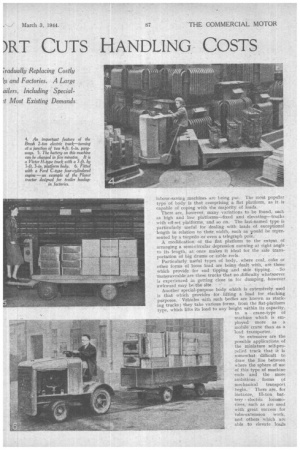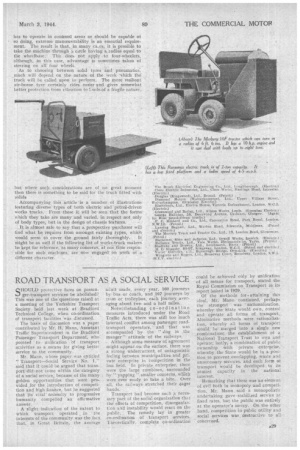MECHANIZED INTERNAL TRAT )RT CUTS HANDLING COSTS
Page 26

Page 27

Page 28

Page 31

If you've noticed an error in this article please click here to report it so we can fix it.
Easily Managed Machines Manual Transportation Met Variety of Chassis, Both purpose Equipment, is Avai. ;radually Replacing Costly and Factories. A Large ailers, Including Special!I Most Existing Demands
A N essential piece of equipment in any sizable works .tois the self-propelled truck driven by either electricity or petrol. Not only does the employment of such machines result in a substantial monetary saving in handling costs, but the overall elect on production generally is of far-reaching importance, particularly under presentday conditions. Even were man-power not a consideration, the capabilities Of the htman frame are definitely ihnited, and increased work is possible only by -adding to the number of operatives engaged.
Where men would, of necessity, have to be employed on the work, boys and girls are quite capable of handling a mechanical truck. In point of fact, girls appear to possess a particular aptitude in this sphere and, therefore, we .find that the control systems of the smaller trucks have, more or less, been designed around this type of labour.
For sheer simplicity of control, operation and maintenance, the electrically driven truck reaches a high standard, but the docility of the internal-combustion-engine types and the foolproof nature of the controls, bring them almost on a par, in these respects, with the battery-driven types.
• Actual selection between the two forms of motive, power is purely a matter of individual preference but, in certain .
circumstances, there may be overriding factors which will rule out one or the other. For instance, where the question of hygiene is a paramount factor, the electric truck will, obviously, bethe type selected. We . have in mind hospitals, sanatoria and such-like institutions where quiet running and freedom from exhaust-fumes are of vital importance.
Whether it be an electric or a petrol truck, the types of body or special-purpose equipment available are 'extremely varied, which indicates the. extensive use to which these
labour-saving machines are being put. The most popular type of body is that comprising a flat platform, as it is capable of coping with the majority of loads. There are, however, many variations to be found, such as high and low platforms—fixed and elevating—trucks with off-set platIonris, and so on. The last-named type is particularly Useful for dealing with loads of exceptional length in relation to their, width, such as vould be represented by a torpedo or even a telegraph pole.
A modification of the flat platform to the extent of arranging a semi-circular depression running at right angle to its length, at once makes it ideal for the safe transportation of big drains or cable reels, Particularly useful types of body, . where coal, coke or other forms of loose load are being dealt with, are those which provide for end tipping and side tipping. So manceuvrable are these trucks that no difficulty whatsoever is experienced in getting close in for dumping, however awkward may be the site. • • Another special-purpose body which is extensively used is thist which provides for lifting a load for stacking purposes. Vehicles with such bodies are known as stacking trucks; they take various forms, from the fiat-platform type, which lifts its load to any height within its capacity, to a • crane-type of machine which is employed more' as a mobile crane than as a load transporter.
So extensive are the possible applications of
• the miniature self,propulled truck that it is somewhat difficult to draw the line between where the sphere of use of this type of machine ends and the more ambitious forms Qi .mechanical transport begin. • There are, for instance, 15-ton battery electric locomotives, such as are used with great success for tube-extension work, And others which are able to elevate loads
up to' and exceeding 7 tons to a height ol 10 ft. or more.
From the foregoing brief summary, it will be ` appreciated that it would be a most unusual requirement that could not effectively be met by industrial-truck makers who, incidentally, are at all times willing to give prospective users the benefit of their experience in the evolving of special-purpose equipment.
In the petrol-driven-truck field we find singlecylindered, two-cylindered and four-cylinclered types, the engine capacity ratings ranging from h.p. up to 50 h.p. or more. It may be thought that machines such as are suggested by as high a rating as 50 h.p. scarcely come within the range of works trucks. There are, however, many specially designed mechanized carriers which, by reason. of the fact that they operate within the confines of the works and are, more or less, unsuitable for other service, come within this category. Whilst all types, without exception, are real man-power savers, the more arnbitious machines perform prodigious tasks. An example, and one in which the powerful petroldriven machine shows to particular advantage, is in the transport and stacking of huge loads of timber. The elevating types on such work perform the stacking in as many minutes as it would take hours by man-power alOne.
The usual advantages attached to multiple-gear ratios scarcely apply in the case of the average works truck as. in the normal way, a high torque with a moderate to low rate of travel forth the main essentials. Hence we find that, in some cases, the drive from the engine is taken, via a clutch and suitable fixed reduction gear, direct to one of the wheels.
Heavy-duty trucks are often provided with a gearbox having, specially chosen gear ratios to give a close range of road speeds from say, 1 m.p.h. to 7 m.p.h. . So far as the low-powered machines are concerned, the controls are such that a boy or girl can become familiar with them in a minimum of time. In actual fact, an intelligent girl can usually learn to handle a small truck quite well after an hour or two of practical instruction. -• In the battery-electric types. the controls are reduced to their simplest possible form. Such a truck is easy to maintain arid, provided the small number of lubrication points be periodically attended to, it should he capable,of performing useful work for many years.
As an example of the running costs of such a machine, a 2-tonner„ for example, requires, roughly, 10 units of electricity for a complete charge, which • is considered as sufficient for about an eight-hour shift. The fitting of larger-capacity batteries would, of course, extend the period 'between recharging.
In view of the fact that the majority of works trucks has to operate in confined areas or should be capable of so doing, extreme manceuvrability is an essential requirement. The result is that, in many ca-es, it is possible to take the machine through a circle having a radius equal to the wheelbase. TIM does not apply to four-wheelers, although, in this case, advantage is sometimes taken of steering on all four wheels. • As to choosing between solid tyres and pneumatics, _lunch will depend on the nature of the work nadch the
truck sill be called upon to perform. The more resilient air-borne tyre certainly rides easier and gives somewhat Letter protection from vibration to 1.)ads,of a fragile nature,
but where such considerations are of no great moment then there is something to be said for the truck fitted with solids . •
Accompanying this article is a number • of illustrations featuring diverse' types of both electric and petrol-driven' works trucks. From these it will be seen that the forms whichthy take are many and varied, in respect not only of body types; but in thedesign of chassis feattires,
: It is almost safe to say that a prospective purchaserwill find what he requires from amongst existing types, which,
would seem to cover the ground fairly thoroughly. It might be as well if the following list of works-truck makers be kept for reference, as many concerns; at one time responsible for such machines, are .nOw engaged on work of a different character. The Brush Electrical Engineering Co., Ltd., instgbi,oreugh. (Electric%) Clew Electric Industries, Ltd., deco Works. Hastings Road, Leicester. (Electric.) -Douglas 'Cliingswoodh Ltd., Bristol. (Petrol.)
Diamond -Motors (Wolverhamp(on), Ltd., rpper Villiers Sued, Wolverhamon pt. (Graiseley Electric.) • . • • Electricars, Ltd., Electra House, Victoria Embankment, London, W.0.2. (Electric.) . Greenwood and Batley, Ltd., Albion Works, Leeds. (Greenbat Eleetried , George Halliday, 56, Deanwood Avenue, Catheart, Glasgow. (awe, tor Ross Petrol-driven trucks.)
F. C. Hibberd and Co., Ltd., Coronation Road. Park Royal, London, N.W.10. (Petrol.) • , Lansing Baguet% Ltd., Worton Road, Isleworlh; Middlesex. , )Petrol and electric.)
The Mercury Truck and Tractor Co.. Ltd., 19, London Road, Gloucester. (Petroll
Ransomes. Sims and Jefferies, Ltd , Orwell Works, Ipswieh. (Electric.) Reliance Trucks, Ltd. Vale Works, Ileckmondvae, 'jerks. (Petrol.) Shelvoke and Drewry,' Ltd., Leteliworth, Doris.. (Petro1.1 • ' • .11. C. Slingeby, 89-97, Ringsway, London, W.C.2. (Petrel and electric.)
Victor Electrics, Surscough. Bridge, Ormskirk. lEectric.) Wingrove and Rogers. Ltd., Broadway Court, Broadway, London, S.W.1. (REA. electrie1




















































